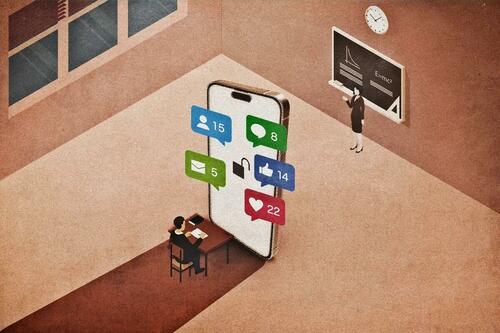Are Smartphones Really Making Kids Dumb?

After decades in the classroom, award-winning teacher Steve Gardiner, of Billings, Montana, became acutely aware of a new problem making it difficult for his high-school students to learn.
Ironically, it was the so-called smartphone.
“The phones were disruptive and distracting—the most disruptive and distracting thing in the classroom in my 38 years of teaching,” Mr. Gardiner, now retired, told The Epoch Times.
“Students could not stop looking at them. And when they weren’t looking at them, they were thinking about looking at them. I called it an addiction.”
Experts now are calling attention to how smartphone use in the classroom can have negative effects on learning and safety at school. They show evidence that suggests allowing students to keep the devices with them during the school day leads to poorer academic performance, and sometimes even compromised safety and an increased chance of devastating consequences of bullying.
Mr. Gardiner takes teaching—and impediments to it—seriously. He holds a doctorate in education, and served three years on the board of directors of the National Board for Professional Teaching Standards. He was Montana’s Teacher of the Year in 2008.
While teaching English at Billings Senior High School, he was so concerned about the impact of phones on learning that he conducted an informal survey. He asked eight business owners in town how they addressed employee use of cell phones on the job.
“It was amazing,” Mr. Gardiner said. “All but one had a variation of the same policy, and that was that texting on the job was not allowed, and an employee would be given two warnings, if caught texting, and after that, he would be terminated.”
The only exception was the local newspaper, he said, because staff sending texts “to ask questions, research, and receive information was part of the job.”
As the government response to the COVID-19 pandemic caused social isolation and prolonged absences from school, children’s time online increased dramatically.
In the United States, children and teens aged 10 to 14 more than doubled their daily time online, going from an average of 3.8 hours to 7.7 hours, according to research published in a JAMA Pediatrics research letter on Nov. 1, 2021.
Even as quarantine restrictions were reversed, the authors wrote, “screen use remains persistently elevated.”
Almost all students have smartphones now.
“Getting a smartphone is now a rite of passage for most children and adolescents in the United States,” states Common Sense Media in its 2023 study titled “Constant Companion: A Week in the Life of a Young Person’s Smartphone Use.”
The study notes that “about half of U.S. children get their smartphone by age 11.”
Common Sense Media—citing its own data and research from Peggy Rideout and the Pew Research Center—reported that 88 percent to 95 percent of teens (aged 13 to 18) have their own smartphone.
Shortly after Apple introduced the iPhone in 2007, almost all schools implemented some sort of ban on phones.
But the breadth of the ban has fluctuated over the years.
In 2009, 90 percent of U.S. schools had bans on cell phones in class, according to the National Education Association (NEA).
By 2015, only 67 percent of schools had cell phone bans.
In 2020, the number of schools banning smartphones had jumped back up to 77 percent of schools, according to the National Center for Education Statistics.
Teachers have been competing with cell phones for the eyes and ears of students for more than a decade, an insight documented by a 2010 Pew Research Center study. It includes data from 2009, when 90 percent of U.S. schools had cellphone bans.
Of the teens surveyed, 62 percent said they could have their phones in school but not in class, and 24 percent were not allowed to have phones on school property. Of those who attended a school with a total ban, 65 percent brought their phones to school anyway, and 58 percent texted in class.
While in class, 64 percent of teens said they had texted, and 25 percent had made or received a call, researchers found.




